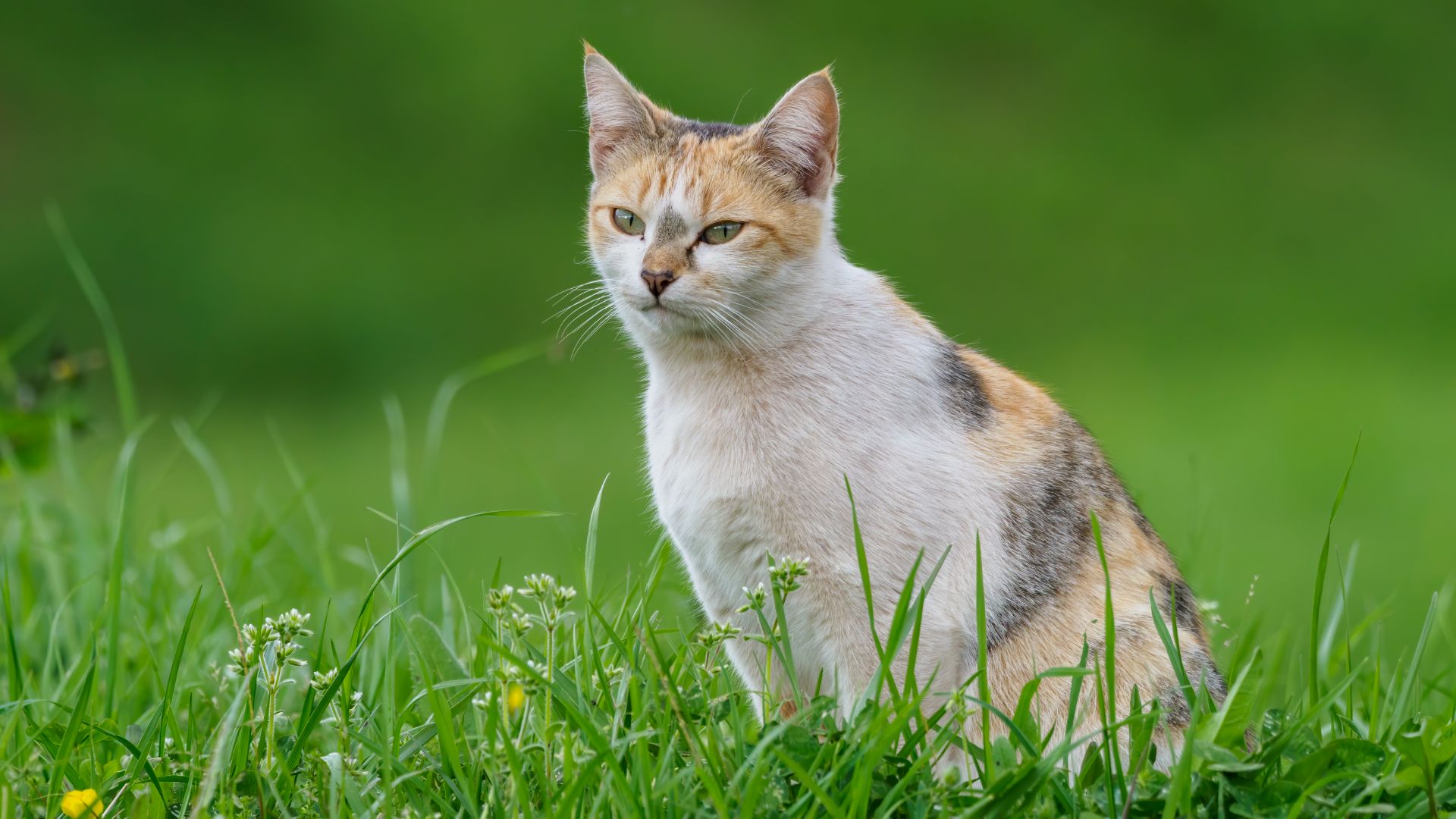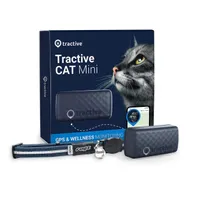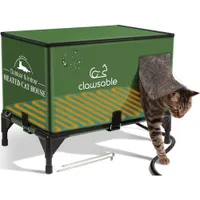How to care for outdoor cats to keep them safe and healthy
Nature's backyard poses a serious of risks for our felines, but there are plenty of benefits too. Here's how to care for your outdoor cat

Outdoor cats may be a smaller group than indoor cats, but they still make up a sizable number of the feline population so knowing how to care for outdoor cats is important. If you’ve found that your beloved ball of fur would rather spend their days roaming about in nature than curled up on one of the best cat beds, knowing the pros and cons of letting your cat go outside and how to keep them safe is super important.
According to a study published in the academic journal Animals (Basel), around 63% of domestic cats in the United States live their lives inside, with little or no access to the great outdoors. In contrast, in many European countries, that number drops to around 26%, with more cats being allowed to roam free. Regardless of which side of the world you live on, if you decide to have an outdoor cat, there are a few things worth considering.
While the great outdoors provides a superior environment for physical exercise and is great for keeping your kitty mentally stimulated, unless you have one of the best outdoor cat enclosures for your feline friend, it also increases the risk of your cat contracting an infectious disease, can mean cats get fleas and ticks, and risks exposure to a range of potential threats, such as traffic and predators.
There’s no denying that our feline friends who spend most of their time outdoors live a more dangerous life than their brothers and sisters who spend their days in the safety and comfort of home. But, that doesn’t mean that your cat can’t thrive as an outdoor cat. Below, we walk you through the pros and cons of this lifestyle and what you can do to ensure your beloved bundle of fur stays happy and healthy.
Outdoor cats: the pros
There are so many wonderful benefits to allowing your feline friend regular access to the great outdoors. Here are a few of our favorites:
1. More exercise
Outdoor cats have a lot more opportunity for exercise than indoor cats (who might benefit from some home-based cat exercises), with nature serving as one massive playground for them to enjoy.
According to companion animal vet Dr Rebecca MacMillan, the health benefits of this are manifold. “Cats that spend time outside are less likely to be overweight as they can roam, climb, and hunt as they wish, and have the incentive to do so,” she explains, adding that: “Being a healthy body weight reduces the risk of diabetes, feline lower urinary tract disease, and cancer.”
Get the best advice, tips and top tech for your beloved Pets
2. Banishes boredom
Is your cat bored? Even with the best cat toys at their disposal, indoor cats are prone to periods of boredom and this can often result in unwanted protest behaviors, such as scratching the furniture or peeing outside of the litter box. Nature provides a wonderfully stimulating and enriching environment for cats that is exactly what their ancestors would have experienced.
“Going outdoors is excellent mental stimulation for cats, even if they only sunbathe in the garden,” says Dr MacMillan. “A change of scenery, fresh air, UV light, and exposure to natural sounds and smells are all proven to be great mood boosters in people, so the same is likely true for our pets.
“Going outdoors could therefore be considered important to your cat's mental wellbeing.”

3. Taps into their natural instincts
Cats are natural predators and the great outdoors offers so many opportunities for them to tap into all those instincts that are hardwired into them, such as stalking, chasing, and pouncing. Not only does play with their prey (whether it be a mouse or a moving flower) provide your cat with a great full-body workout, it also helps keep their mind sharp and engaged.
Outdoor cats: the cons
It’s clear that there are plenty of perks to outdoor life, but there are also some serious drawbacks that need to be carefully considered before you decide to grant your cat unlimited access to the world beyond the safety of home.
1. Lower life expectancy
According to the Animal Humane Society, letting your cat spend time outdoors could shorten their lifespan by as much as 10-12 years! Road traffic accidents in particular are a huge concern for cats with unlimited outdoor access with a study published in Animals (Basel) showing that 45% of cats crossed the road while being monitored.
“A cat that goes outdoors is more likely to become involved in some kind of accident,” warns Dr MacMillan, “this could be a road traffic accident, a fall, ingesting something toxic, or being bitten by another animal.”
2. Increased risk of getting lost
Unless you’ve fitted your kitty with one of the best pet trackers, letting them roam free greatly increases the risk that your feline friend will wander too far and be unable to find their way home. This is particularly common in the winter when the cold temperatures can cause animals to become disorientated.
As well as getting lost, there’s also a chance that your cat may find themselves locked in someone’s garden shed or get trapped in an abandoned house or building. If your cat isn’t wearing a tracker or collar with identification, a good Samaritan may find them, and thinking they’re a stray, take them to the nearest animal shelter.
Tractive Cat Mini Pet Tracker | Amazon
This GPS tracker fits onto your cat’s collar and allows you to track their live location. You can set a virtual fence so you know when your kitty strays from your home zone. Subscription required.
3. More likely to get sick
Being outdoors greatly increases the chance that your cat will pick up an infectious disease.
“Territory tensions can arise between outdoor cats leading to fights and anxiety,” says Dr MacMillan. “Cats that fight or mate with other cats are more likely to contract diseases such as feline immunodeficiency virus (FIV).”
As well as FIV in cats, there are a range of diseases that can be spread on contact and these include:
- Feline infectious peritonitis (FIP)
- Feline leukemia virus (FeLV)
- Feline Distemper (FPV)
- Toxoplasma gondii
- Upper respiratory infections
It’s really important if you’re planning on letting your cat spend the bulk of their time outdoors that all of their vaccinations are up to date. Nature is also the place where fleas, ticks, lice and mosquitoes run rampant, so it's worth investing in the best flea treatment for cats to protect your kitty from pesky parasites.
How to care for outdoor cats
While outdoor cats are going to encounter more risks on a day to day basis than indoor cats, that doesn’t mean that you need to keep your feline friend cooped up inside against their will. If you do decide that granting your moggy access to the outdoors is the path you want to go down, here are our top tips for caring for outdoor cats:
1. Make sure your cat’s ID is up to date
It’s crucial that your kitty can be quickly and easily identified if they happen to get lost. We recommend you fit them with a pet tracker, a safety collar with a breakaway mechanism in case they get stuck, an ID tag with their name and your contact details, and a microchip.
“Microchipping your cat is essential, and in many countries, it is now a legal requirement,” explains Dr MacMillan. “This will increase the chances that you are reunited with your pet if they go missing or become involved in an accident.
“Pet insurance is advisable for all pets, but outdoor cats are at increased risk of becoming involved in an accident or fight with another animal.”
2. Spay or neuter your cat
Spaying or neutering your pet is a must if they’re going to be living largely outdoors.
“There is no vaccination currently available for feline immunodeficiency virus (FIV) but neutering your pet will greatly reduce the chances of them contracting this disease,” advises Dr MacMillan.
“FIV is primarily spread through fighting and mating, which outdoor cats are less likely to do if they have been spayed or castrated.
“Additionally, neutering your pet will also eliminate the risk of unwanted pregnancy in female cats. In males, it reduces the chances of your male cat roaming, which could lead to them becoming lost or involved in a road traffic accident.”

3. Keep your cat’s vaccinations up to date
It’s worth speaking to your vet about what vaccinations your outdoor cat is going to need and if these are only administered once or whether an annual shot is advisable.
“Vaccinating your outdoor cat is essential to reduce their risk of contracting disease from other cats such as cat flu and feline infectious enteritis,” says Dr MacMillan. “Your cat will require a primary course as a kitten then annual boosters for the rest of their life to guarantee ongoing immunity.”
You might also like to talk through your flea treatment and prevention options to decide whether a topical treatment or one of the best flea collars for cats is going to be more suitable for your feline friend.
“Routine anti-parasite treatment is important for keeping outdoor cats comfortable and in good health,” adds. Dr MacMillan. “The risk of picking up fleas, worms, and other parasites is high if they spend a lot of time outside.
“You should always use vet-approved products to guarantee their effectiveness and administer it at the recommended intervals.”
4. Ensure your cat has access to food and water
Whether it’s the best wet cat food or the best dry cat food, you’re going to want to make sure that your moggy doesn’t miss a meal when they venture home - and that they have plenty of fresh water available to them.
One option is to fit a one of the best microchip cat flaps into your home as this will allow your kitty to come and go as they please. You could also set up an area outdoors that they can visit to eat and drink, although you do run the risk of all the other cats in the neighborhood swinging by too!
5. Invest in an outdoor cat house
If you have a cat who pops out for the day and then returns at night, setting up an outdoor cat house isn’t likely to be necessary. However, if you have a feline friend who prefers to spend the bulk of their time outside, one of the best outdoor cat houses will do a wonderful job of keeping them warm in the winter, providing shelter against the elements and protecting them from predators.
“A covered area or maybe even a cat flap into a shed or outbuilding will give your outdoor cat somewhere to hide in poor weather,” says Dr MacMillan. “You could encourage them in there with a comfortable bed and treats.”
Clawsable Outdoor Cat House | Amazon
This weatherproof outdoor cat house has a heated floor to keep your outdoor feline friend toasty warm.
6. Check your cat over regularly
It’s a really good idea to give your outdoor cat a thorough going over whenever they pop inside to say hello.
Says Dr MacMillan:“You should still try and handle your cat regularly and check them over for any abnormalities. Regular positive handling with plenty of treats and fuss, will ensure that they keep coming back to you for more. ”
Look for fleas and ticks and use the right type of cat brush for your feline's coat to work through any tangles to help prevent and treat matted cat fur and keep their skin and coat healthy.
Curious about what your outdoor-dwelling feline friend might be trying to tell you when they come home from their adventures? Then be sure to check out our guide to cat communication for a full translation! Are you questioning, can cats find their way home? This feature has the answers you're looking for.

Kathryn is a freelance writer who has been a member of the PetsRadar family since it launched in 2020. Highly experienced in her field, she's driven by a desire to provide pet parents with accurate, timely, and informative content that enables them to provide their fur friends with everything they need to thrive.
Kathryn works closely with vets and trainers to ensure all articles offer the most up-to-date information across a range of pet-related fields, from insights into health and behavior issues to tips on products and training.
When she’s not busy crafting the perfect sentence for her features, buying guides and news pieces, she can be found hanging out with her family (which includes one super sassy cat and a kitten), drinking copious amounts of Jasmine tea and reading all the books.
She has written for a range of publications, including Fit&Well, Top Ten Reviews, LiveScience, Goodto, and Product Hunt.
- Bethany StoneFreelance Writer


